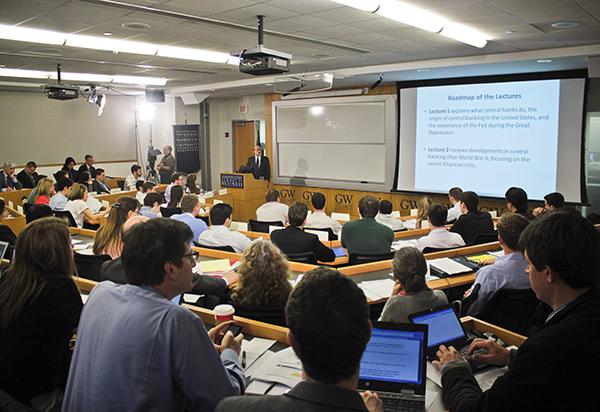GW is set to put the Federal Reserve under a microscope as it prepares to launch its second massive open online course as soon as this spring.
The free class will open to the public even as experts nationwide have cast doubt on such courses’ chances for success. GW has entered the MOOC fray later than many colleges, in the hopes that waiting would give officials time to learn the best way to produce and market the free courses.
It will likely launch a few months later than officials had anticipated when they announced plans for the course last December. The University released its first MOOC this fall and is in the process of creating more, said Paul Schiff Berman, the vice provost for online education and academic innovation.
GW partnered with Pearson Education to develop the course. While the University has looked to online courses to offset a decline in graduate enrollment on campus, a MOOC will not serve as a new revenue source.
Critics have said that these online courses provide few benefits for universities, which spend money to create the programs but don’t reap financial benefits. Few students who sign up for MOOCs complete the course, and many have cast them off as a higher education fad that could simply become a component of more traditional courses.
Four professors with expertise in what Berman has called “one of the nation’s most misunderstood institutions” filmed their segments and panel discussions for the Federal Reserve MOOC this summer. Those elements will compliment footage from several conferences about the Fed and material from lectures by former Chairmen Ben Bernanke and Paul Volcker, who have both spoken on campus.
Berman said the MOOC, which was made to celebrate the Federal Reserve’s 100th anniversary, would take a look at how the banking system has handled world economic crises over the past century.
“[Bernanke] was able to discuss – in a way that no one else possibly could – the two most significant world economic crises of the past century, and provide insights and observations about the banking system and the Fed’s role in dealing with economic emergencies,” Berman said in an email.
The course will be split into six parts: two panel discussions, and individual sessions with professors who have studied the Federal Reserve from different subject areas.
Robert Van Order, the chair of GW’s finance department, said the course looks at different aspects of the Federal Reserve, like its origins and role in growing the economy after World War II.
“The idea was to design it for someone who was interested in the Fed, but didn’t have an economic background,” he said. “This isn’t the sort of thing that we think of as a four-credit course.”
Arthur Wilmarth, a law professor, said the conferences and events with Bernanke and Volker would add to what the professors had to say and better engage students.
“The four of us basically drafted out a course, which basically will have six videotaped episodes, basically tracing the history of the Fed over its century of existence,” he said. “Students can visualize the idea of all these various videotapes of conferences and interviews.”
School of Media and Public Affairs Director Frank Sesno, a former special correspondent for CNN, interviewed each of the professors and led the panel discussions. He also advised the MOOC’s producers on how to make the course more interactive.
“When someone is sitting watching a video presentation, the production value assumes a level of importance that it doesn’t assume in the classroom when you’re physically present with someone,” he said. “You have to find that sweet spot between academic integrity, rigor and expertise, and production value to make it a truly compelling experience for the viewer.”
Jane Manning, the director of platforms in the Office of the Vice Provost for Online Learning at Stanford University, said she still sees potential in MOOCs.
“I think many universities are still figuring out where MOOCs fit in to the range of things they do,” she said, adding that while some of the “hype-shine” is gone, they can help “raise the status of teaching, inspire faculty and enable different teaching methods.”
GW has come to the MOOC scene later than other colleges, like Stanford and Georgetown universities, which Ann Kirschner, the dean of the Macaulay Honors College at the City University of New York, said gives a school the chance to first look at how the courses engage students.
She said universities that build successful MOOCs focus on their strengths. Since GW is only blocks from the Federal Reserve, it is “an area where the University probably has particular standing,” she said.
“I think it’s a great learning experiment to see how a university will break down boundaries between its mission and its audience,” Kirschner said.
Colleen Murphy contributed reporting.







